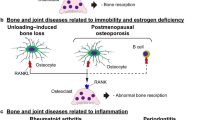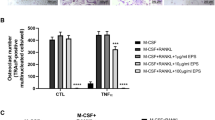Abstract
Lactoferrin is a pleiotropic factor with potent antimicrobial and immunomodulatory activities. In recent years, studies have shown that lactoferrin also acts on the skeleton to promote bone growth. Lactoferrin stimulates the proliferation and differentiation of the bone forming cells, the osteoblasts, and acts as a survival factor for these cells. Lactoferrin also inhibits osteoclastogenesis, reducing the number of cells that can actively resorb bone, thus producing a greater overall increase in bone volume. In vivo, local injection of lactoferrin results in substantial increases in bone area, establishing lactoferrin as an effector molecule in the skeleton. Investigations of the mechanism of action of lactoferrin in bone cells showed that the mitogenic effect of lactoferrin in osteoblasts is mediated mainly through LRP1, a member of the low density lipoprotein receptor-related proteins. Lactoferrin induces activation of p42/44 MAPK signaling as well as PI3-kinase-dependent phosphorylation of Akt in osteoblasts. Differential gene expression studies indicated a possible role for the activation of IGF1, Ptgs2 and Nfatc1 in mediating the mitogenic activity of lactoferrin in osteoblasts. Lactoferrin is a positive regulator of bone with a possible physiological role in bone growth and healing. There is a growing interest in the potential use of lactoferrin for the improvement of bone health, and in a number of recent studies dietary lactoferrin supplementation improved bone mineral density and bone strength. Lactoferrin appears to be a promising candidate for the development of an anabolic therapeutic factor for osteoporosis.


Similar content being viewed by others
References
Bharadwaj S, Naidu AG, Betageri GV, Prasadarao NV, Naidu AS (2009) Milk ribonuclease-enriched lactoferrin induces positive effects on bone turnover markers in postmenopausal women. Osteoporos Int 20:1603–1611
Blais A, Malet A, Mikogami T, Martin-Rouas C, Tome D (2009) Oral bovine lactoferrin improves bone status of ovariectomized mice. Am J Physiol Endocrinol Metab 296:E1281–E1288
Cornish J, Callon KE, Naot D, Palmano KP, Banovic T, Bava U, Watson M, Lin JM, Tong PC, Chen Q, Chan VA, Reid HE, Fazzalari N, Baker HM, Baker EN, Haggarty NW, Grey AB, Reid IR (2004) Lactoferrin is a potent regulator of bone cell activity and increases bone formation in vivo. Endocrinology 145:4366–4374
Cornish J, Palmano K, Callon KE, Watson M, Lin JM, Valenti P, Naot D, Grey AB, Reid IR (2006) Lactoferrin and bone; structure-activity relationships. Biochem Cell Biol 84:297–302
Grey A, Banovic T, Zhu Q, Watson M, Callon K, Palmano K, Ross J, Naot D, Reid IR, Cornish J (2004) The low-density lipoprotein receptor-related protein 1 is a mitogenic receptor for lactoferrin in osteoblastic cells. Mol Endocrinol 18:2268–2278
Grey A, Zhu Q, Watson M, Callon K, Cornish J (2006) Lactoferrin potently inhibits osteoblast apoptosis, via an LRP1-independent pathway. Mol Cell Endocrinol 251:96–102
Guo HY, Jiang L, Ibrahim SA, Zhang L, Zhang H, Zhang M, Ren FZ (2009) Orally administered lactoferrin preserves bone mass and microarchitecture in ovariectomized rats. J Nutr 139:958–964
Ji ZS, Mahley RW (1994) Lactoferrin binding to heparan sulfate proteoglycans and the LDL receptor-related protein. Further evidence supporting the importance of direct binding of remnant lipoproteins to HSPG. Arterioscler Thromb 14:2025–2031
Legrand D, Vigie K, Said EA, Elass E, Masson M, Slomianny MC, Carpentier M, Briand JP, Mazurier J, Hovanessian AG (2004) Surface nucleolin participates in both the binding and endocytosis of lactoferrin in target cells. Eur J Biochem 271:303–317
Lorget F, Clough J, Oliveira M, Daury MC, Sabokbar A, Offord E (2002) Lactoferrin reduces in vitro osteoclast differentiation and resorbing activity. Biochem Biophys Res Commun 296:261–266
Suzuki YA, Shin K, Lonnerdal B (2001) Molecular cloning and functional expression of a human intestinal lactoferrin receptor. Biochemistry 40:15771–15779
Takayama Y, Mizumachi K (2008) Effect of bovine lactoferrin on extracellular matrix calcification by human osteoblast-like cells. Biosci Biotechnol Biochem 72:226–230
Takayama Y, Mizumachi K (2009) Effect of lactoferrin-embedded collagen membrane on osteogenic differentiation of human osteoblast-like cells. J Biosci Bioeng 107:191–195
Vash B, Phung N, Zein S, DeCamp D (1998) Three complement-type repeats of the low-density lipoprotein receptor-related protein define a common binding site for RAP, PAI-1, and lactoferrin. Blood 92:3277–3285
Willnow TE, Goldstein JL, Orth K, Brown MS, Herz J (1992) Low density lipoprotein receptor-related protein and gp330 bind similar ligands, including plasminogen activator-inhibitor complexes and lactoferrin, an inhibitor of chylomicron remnant clearance. J Biol Chem 267:26172–26180
Acknowledgments
We thank Dr J.M. Lin for testing the activity of lactoferrin in RAW264.7 cells.
Author information
Authors and Affiliations
Corresponding author
Rights and permissions
About this article
Cite this article
Cornish, J., Naot, D. Lactoferrin as an effector molecule in the skeleton. Biometals 23, 425–430 (2010). https://doi.org/10.1007/s10534-010-9320-6
Received:
Accepted:
Published:
Issue Date:
DOI: https://doi.org/10.1007/s10534-010-9320-6




